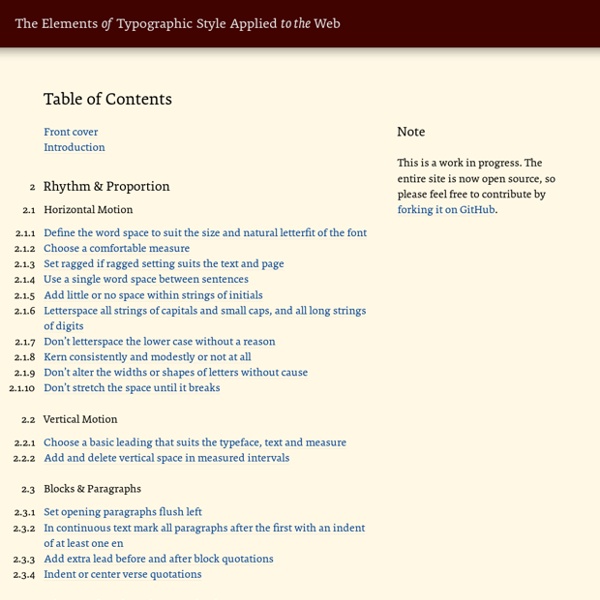



Book Designer David Moratto, Book Design Glossary The following will help you understand the three main structures that an interior book design is comprised of and terminologies that a book designer and a printer might use. Front Matter (components that may appear at the begining of a book before the first chapter) Body Matter (components that may appear in the work of a book) Back Matter (components that may appear at the end of the book after a work) The following are terms that a book designer and a printer might use:
How to Speak Typography: Terms You Should Know If you are just beginning as a graphic designer, you should be knee-deep in typography, learning how to use it properly and how to speak about it using proper terminology. This is by no means an exhaustive list of typographic terms, but getting to know these and how to apply them will go a long way toward developing anyone as a typographer and designer. Baseline The invisible line upon which the letters of a typeface rest. Letters with flat bottoms (E) are normally flush with the baseline, while curved characters normally descend below it (and also ascend above the cap height). It matters because:
Typographer's Glossary Serif: Serif's are semi-structural details on the ends of some of the strokes that make up letters and symbols. A typeface that has serifs is called a serif typeface (or seriffed typeface). Some of the main classifications of Serif type are: Blackletter, Venetian, Garalde, Modern, Slab Serif, Transitional, and Informal. Fonts in each classfication share certain similiar characteristics including the shape or appearance of their serifs. Serif fonts are widely used in traditional printed material such as books and newspapers. Touche, la robusta fuente geométrica con personalidad La famila Touche fue creada en 2015 por el tipógrafo Jonny Pinhorn, uno de los miembros de la fundación Indian Type Foundry. El objetivo del diseñador era conseguir una tipografía san serif geométrica pero con características formales que se alejaran de las formas básicas típicas que se repiten en multitud de tipografías del mismo grupo. Es decir, necesitaba darle un toque diferente.
Klim Type Foundry - Lettering & Logotypes Under direction from Kevin Wilson & Mark Leeds. For Spark. Under direction from Kane McPherson & Shabnam Shiwan at Saatchi & Saatchi. For Z Zegna. Under directon from Andrew Wren at Out There in New York. Haettenschweiler - letrag Creada por el equipo de diseño de la fundición Monotype en 1995, está basada en una tipografía más condensada aún llamada Schmalfette Grotesk, diseñada por Walter Haettenschweiler y que fue muy popular en la década de 1960. Esta fue vista por primera vez en un espléndido libro llamado “Lettera” de Walter Haettenschweiler y Armin Haab. La Schmalfette Grotesk (“schmalfette” significa “negrita condensada” en alemán y “grotesk” indica la ausencia de serifs) era un alfabeto muy condensado con todas las letras mayúsculas y que fue inmediatamente adoptado por los diseñadores de la revista “Paris Match” para utilizar en titulares. Debido a la popularidad de este estilo, pronto empezaron a aparecer otras tipografías extracondensadas y con gran peso como la Helvética imitando la Schmalfette original. Photoscript hizo una versión con minúsculas y más tarde sacaron otra versión menos condensada llamada Haettenschweiler Extended en tributo al diseñador original.
Wenting Zhang's 100 days project Typedia In a nutshell, Typedia is a community website to classify typefaces and educate people about them. Think of it like a mix between IMDb and Wikipedia, but just for type. Anyone can join, add, and edit pages for typefaces or for the people behind the type. 10 Display Faces that Digital Forgot Because of your enthusiastic response to my last column, I’ve moved up its sequel. In this installment, I’ll be looking at display and decorative faces that were somehow left in the archives when the winds of digital technology swept through the dusty vaults of yesteryear’s metal type foundries. Of all the thousands of typefaces that are created each year, the lion’s share are display and decorative faces. That’s because these are easier to create than text faces (almost anything goes), and changing fashion demands novel looks at dizzying speeds. What I’ve looked for in assembling the faces shown here, though, are those with the key attribute of versatility, faces that can adapt themselves to a host of environments and situations.
typografiebücher <div class="global-site-notice noscript"><div class="notice-inner"><p><strong>JavaScript scheint in Ihrem Browser deaktiviert zu sein.</strong><br />Sie müssen JavaScript in Ihrem Browser aktivieren, um alle Funktionen in diesem Shop nutzen zu können. </p></div></div> Tabea Hartwich | Jana Kemmer Overlap Tabea Hartwich | Jana Kemmer Overlap Bernd Kuchenbeiser 61 books with black type on white cover (Kleinformat) Bernd Kuchenbeiser 61 books with black type on white cover (Grossformat) Christian Fischer, Johannes Eckert, Ilona Pfeifer, Philipp Schäfer, Andreas Uebele – Fachhochschule Düsseldorf, Fachbereich Design (Hrsg.) Schrift und Identität Slanted c/o Magma Brand Design (Hrsg.) Yearbook of Type I
How to Choose the Right Typeface for Your Website – ExpandTheRoom – Medium 3. Solve for your project’s unique challenges. Each typeface has specific features to solve unique design challenges. Some typefaces are better suited for your project than others. Here’s a few bells and whistles to look for before committing to a typeface: superfamilies, optical sizes, a range of widths and weights, language support, and font features. Superfamilies